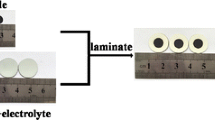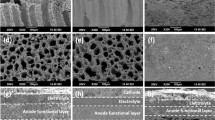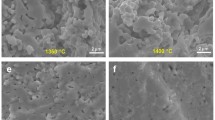Abstract
In this study, the planar anode-supported solid oxide fuel cells with straight opening pores were prepared by phase inversion method and the laser ablation technique. The microstructure, thermal expansion behavior, porosity and bending strength of anodes with 3 mol% Y2O3 doped ZrO2 (3YSZ) and 8 mol% Y2O3 doped ZrO2 (8YSZ) were investigated. The bending strength of 144 MPa for NiO–3YSZ planar anode was achieved, which was two times higher than that of NiO–8YSZ substrate. To improve the electrochemical performance of NiO–3YSZ planar anode, an anode functional layer of NiO–8YSZ was introduced between NiO–3YSZ anode and electrolyte layer by spin-coating method. The maximum power density of single cell with NiO–3YSZ anode was improved from 365 to 598 mW cm−2 at 800 °C.









Similar content being viewed by others
References
Li T, Wu Z, Li K (2015) High-efficiency, nickel-ceramic composite anode current collector for micro-tubular solid oxide fuel cells. J Power Sources 280:446–452
Shri Prakash B, Senthil Kumar S, Aruna ST (2014) Properties and development of Ni/YSZ as an anode material in solid oxide fuel cell: a review. Renew Sustain Energy Rev 36:149–179
Sun H, Chen Y, Yan R, Wei T, Zhang Y, Zhang Q, Bu Y, Liu M (2016) Anode-supported solid oxide fuel cells based on Sm0.2Ce0.8O1.9 electrolyte fabricated by a phase-inversion and drop-coating process. Int J Hydrogen Energy 41:10907–10913
Sun W, Zhang N, Mao Y, Sun K (2012) Preparation of dual-pore anode supported Sc2O3-stabilized-ZrO2 electrolyte planar solid oxide fuel cell by phase-inversion and dip-coating. J Power Sources 218:352–356
Peng S, Zhou D, Wei Y, Li Z, Wang H (2012) A novel U-shaped anode-supported hollow fiber solid oxide fuel cell with considerable thermal cycling performance and stability. J Membr Sci 417–418:80–86
Minh NQ (2004) Solid oxide fuel cell technology—features and applications. Solid State Ion 174:271–277
Xiao J, Cai W, Liu J, Liu M (2014) A novel low-pressure injection molding technique for fabricating anode supported solid oxide fuel cells. Int J Hydrogen Energy 39:5105–5112
Zhao L, Zhang X, He B, Liu B, Xia C (2011) Micro-tubular solid oxide fuel cells with graded anodes fabricated with a phase inversion method. J Power Sources 196:962–967
Horri BA, Selomulya C, Wang H (2012) Electrochemical characteristics and performance of anode-supported SOFCs fabricated using carbon microspheres as a pore-former. Int J Hydrogen Energy 37:19045–19054
Xue Y, Guan W, He C, Wang J, Liu W, Sun S, Wang Z, Wang W (2016) Fabrication of porous anode-support for planar solid oxide fuel cell using fish oil as a pore former. Int J Hydrogen Energy 41:8533–8541
Luo T, Shi J, Wang S, Zhan Z (2014) Optimization of the Solid oxide fuel cell anode by tape casting. J Inorg Mater 29:203–208
Liu T, Wang Y, Zhang Y, Fang S, Lei L, Ren C, Chen F (2015) Steam electrolysis in a solid oxide electrolysis cell fabricated by the phase-inversion tape casting method. Electrochem Commun 61:106–109
Meng X, Yang N, Meng B, Tan X, Yin Y, Ma Z-F, Sunarso J (2012) Microstructure tailoring of the nickel-yttria stabilized zirconia (Ni–YSZ) cermet hollow fibres. Ceram Int 38:6327–6334
Jin C, Yang C, Chen F (2010) Effects on microstructure of NiO–YSZ anode support fabricated by phase-inversion method. J Membr Sci 363:250–255
Yuan R-H, He W, Zhang Y, Gao J-F, Chen C-S (2016) Preparation and characterization of supported planar Zr0.84Y0.16O1.92–La0.8Sr0.2Cr0.5Fe0.5O3−δ composite membrane. J Membr Sci 499:335–342
Othman MH, Droushiotis N, Wu Z, Kelsall G, Li K (2011) High-performance, anode-supported, microtubular SOFC prepared from single-step-fabricated, dual-layer hollow fibers. Adv Mater 23:2480–2483
Huang H, Lin J, Wang Y, Wang S, Xia C, Chen C (2015) Facile one-step forming of NiO and yttrium-stabilized zirconia composite anodes with straight open pores for planar solid oxide fuel cell using phase-inversion tape casting method. J Power Sources 274:1114–1117
Wang Z, Liu H, Tan X, Jin Y, Liu S (2009) Improvement of the oxygen permeation through perovskite hollow fibre membranes by surface acid-modification. J Membr Sci 345:65–73
Shao X, Dong D, Parkinson G, Li C-Z (2014) Microstructure control of oxygen permeation membranes with templated microchannels. J Mater Chem A 2:410–417
Gu D, Shi N, Yu F, Zheng Y, Chen H, Guo L (2018) Asymmetric anode substrate fabricated by phase inversion process and its interface modification for solid oxide fuel cells. J Alloys Compd 742:20–28
Laurencin J, Delette G, Lefebvre-Joud F, Dupeux M (2008) A numerical tool to estimate SOFC mechanical degradation: case of the planar cell configuration. J Eur Ceram Soc 28:1857–1869
Malzbender J, Steinbmh RW, Singheher L (2005) Failure probability of solid oxide fuel cells. Ceram Eng Sci Proc 26:293–298
Nakajo A, Kuebler J, Faes A, Vogt UF, Schindler HJ, Chiang L-K, Modena S, Herle J, Hocker T (2012) Compilation of mechanical properties for the structural analysis of solid oxide fuel cell stacks. Constitutive materials of anode-supported cells. Ceram Int 38:3907–3927
Frandsen HL, Ramos T, Faes A, Pihlatie M, Brodersen K (2012) Optimization of the strength of SOFC anode supports. J Eur Ceram Soc 32:1041–1052
Alston T, Kendall K, Palin M, Prica M, Windibank P (1998) A 1000-cell SOFC reactor for domestic cogeneration. J Power Sources 71:271
Boccaccinia DN, Frandsena HL, Soprania S, Canniob M, Klemensøa T, Gila V, Hendriksen PV (2018) Influence of porosity on mechanical properties of tetragonal stabilized zirconia. J Eur Ceram Soc 38:1720–1735
Zhen S, Sun W, Tang G, Rooney D, Sun K, Ma X (2016) Fabrication and evaluation of NiO/Y2O3-stabilized-ZrO2 hollow fibers for anode-supported micro-tubular solid oxide fuel cells. Ceram Int 42:8559–8564
Hedayat N, Panthi D, Du Y (2017) Fabrication of anode-supported microtubular solid oxide fuel cells by sequential dip-coating and reduced sintering steps. Electrochim Acta 258:694–702
Ai N, Lü Z, Chen K, Huang X, Liu Y, Wang R, Su W (2006) Preparation of Sm0.2Ce0.8O1.9 membranes on porous substrates by a slurry spin coating method and its application in IT-SOFC. J Membr Sci 286:255–259
Wang J, Lü Z, Huang X, Chen K, Ai N, Hu J, Su W (2007) YSZ films fabricated by a spin smoothing technique and its application in solid oxide fuel cell. J Power Sources 163:957–959
Sato K, Okamoto G, Naito M, Abe H (2009) NiO/YSZ nanocomposite particles synthesized via co-precipitation method for electrochemically active Ni/YSZ anode. J Power Sources 193:185–188
Wang B, Lai Z (2012) Finger-like voids induced by viscous fingering during phase inversion of Alumina/PES/NMP Suspensions. J Membr Sci 405:275–283
Tyn MT, Calus WF (1975) Diffusion coefficients in dilute binary liquid mixtures. J Chem Eng Data 20:106–109
Aguadero A, Alonso JA, Escudero MJ, Daza L (2008) Evaluation of the La2Ni1−xCuxO4+δ system as SOFC cathode material with 8YSZ and LSGM as electrolytes. Solid State Ion 179:393–400
Menzler NH, Malzbender J, Schoderböck P, Kauert R, Buchkremer HP (2014) Sequential tape casting of anode supported solid oxide fuel cells. Fuel Cells 14:96–106
Kagomiya I, Kaneko S, Yagi Y, Kakimoto K, Park K, Cho K-H (2017) Dependence of power density on anode functional layer thickness in anode-supported solid oxide fuel cells. Ionics 23:427–433
Yamaguchi T, Sumi H, Hamamoto K, Suzuki T, Fujishiro Y, Carter JD, Barnett SA (2014) Effect of nanostructured anode functional layer thickness on the solid-oxide fuel cell performance in the intermediate temperature. Int J Hydrogen Energy 39:19731–19736
Shi N, Yu S, Chen S, Chen H, Guo L (2017) Dense thin YSZ electrolyte films prepared by a vacuum slurry deposition technique for SOFCs. Ceram Int 43:182–186
Leng YJ, Chan SH, Khor KA, Jiang SP (2004) Performance evaluation of anode supported solid oxide fuel cells with thin film YSZ electrolyte. Int J Hydrogen Energy 29:1025–1033
Blum L, de Haart LGJ, Malzbender J, Margaritis N, Menzler NH (2016) Anode-supported solid oxide fuel cell achieves 70000 hours of continuous operation. Energy Technol 4:1–4
Acknowledgements
This work was financially supported by the Priority Academic Program Development (PAPD) of Jiangsu Higher Education Institutions and National Natural Science Foundation of China (Nos. 21978133 and 21506100).
Author information
Authors and Affiliations
Corresponding author
Additional information
Publisher's Note
Springer Nature remains neutral with regard to jurisdictional claims in published maps and institutional affiliations.
Rights and permissions
About this article
Cite this article
Chen, S., Gu, D., Zheng, Y. et al. Enhanced performance of NiO–3YSZ planar anode-supported SOFC with an anode functional layer. J Mater Sci 55, 88–98 (2020). https://doi.org/10.1007/s10853-019-04007-4
Received:
Accepted:
Published:
Issue Date:
DOI: https://doi.org/10.1007/s10853-019-04007-4




